
Rohit Sharma has been the face of Mumbai Indians over the years but, as the mega-auction beckons, is it finally time to part ways, asks Sarah Waris?
No franchise wants to let go of their star player. Not only does such a player bring with them their own set of loyal fans, they also ensure a rich line of sponsors, who are willing to shell out millions to be associated with the team in question.
The city itself can develop a seemingly unbreakable bond with certain cricketers, and imagining a day when they do not feature in the XI is enough to make supporters nostalgic. But, however much audiences might pine, franchise sport should be bereft of emotions — the ultimate goal is to make the team a success in the future, and accommodating an athlete who has little to offer despite their past showings is not the way forward. Sentimentality and marketability mean little if the team’s fortunes suffer.
Kolkata Knight Riders, known for their passionate fans, were at the receiving end of significant ire when they finally decided to do away with Sourav Ganguly’s services in 2011. Such was the anger that Gautam Gambhir played under half-empty stands in the early part of his captaincy tenure, a sight that was unbecoming of the great Eden Gardens. However, as he achieved success, leading KKR to the first-ever playoffs the same year, the city soon woke to the promise of the new leader.
Mumbai Indians are in a similar predicament. In Rohit Sharma, they have one of the best white-ball batters of the era, and his continued skills as a skipper have further made him Mumbai’s own. But as the deadline for retentions nears, one cannot help but see the dilemma in the camp: do they continue with him as a leader despite his generally middling batting returns, and shell out big money for a 34-year-old, or do they take the harsh option and decide to invest in the future instead?
What about his batting?
Rohit has been playing in the IPL since 2008 and has gone on to become one of the top run-scorers in the competition’s history, with 5,611 runs at an average of 31.17. However, in 14 years, Rohit has maintained a strike rate in excess of 135 in just two seasons, and below 130 on eight occasions. In the last six seasons, the opener has a highest strike rate of 133.02, with a low of 121.97 in 2017. The consistency in his runs has not stopped. He has scored over 300 runs in five of the last six editions, and his strike rate in the late 120s and early 130s has gone unnoticed in a team of big-hitters. Mumbai Indians have forged a dynasty with him in the side, but still, those aren’t quite the numbers you’d hope for from one of the competitions most expensive players.
Is retention a wise move for him?
This brings us to the big question. Emotions aside, is it worth spending INR 15 crore on a player who has been, at best, only just above average in his primary skill because of his captaincy? True, street-smart leaders are a rare breed in T20s, something demonstrated by MS Dhoni and Eoin Morgan. They are two of the last three skippers remaining in IPL 2021, and have guided their teams coolly and consummately despite poor personal campaigns with the bat. Rohit brings more value with the bat than that pair, and his IPL record suggests he is up there as a captain. But the question isn’t, is Rohit a good batter and captain, but rather, does he justify one of the biggest price tags in the competition, at the expense of another player MI might want to retain? With limited retentions allowed ahead of IPL 2022, is having a player, just months short of 35, the best option when future stars such as Ishan Kishan and Suryakumar Yadav are at your disposal?
Though confirmation is awaited, it seems unlikely that as many as six players can be retained ahead of a mega-auction where two new teams will be in the fray. Assuming Jasprit Bumrah, Hardik Pandya, Kieron Pollard, and Rohit are the first four players in the pecking order, either through retention or the Right to Match card, only one of Yadav or Kishan can stay on with the franchise. If fewer than four retentions are possible, then Rohit would have to take the place of one of Bumrah, Pandya and Pollard.
Kishan and Yadav have been at the forefront of MI’s success with the bat over the last few seasons. Yadav’s fearless approach has already made him one of the best T20 batters in the country, while Kishan has shown enough temperament to bounce back after a dip and leave his mark in fine fashion. While both are primarily top-order players, they can stay till the end as well, and enact the role of a finisher, if needs be. What works for them is that, unlike Rohit, they can launch from ball one, which ensures that the run rate is maintained throughout the innings.
With the limited options of finishers in the Indian circuit currently, teams will be well aware that having players who can fulfil similar roles will be of greater value in the long-term, and they would do well to go into the mega-auctions with a similar thought process as well.
Both Yadav and Kishan have been called up for the T20 World Cup this month, and have each made a fantastic start to their international careers. They have all the potential to become the next face of the MI brand. Letting either one of them go would be a big loss to a franchise that has relished continuity and promoted Indian talent while giving them unlimited opportunities. While it might be unfair to Rohit, who has won five titles since 2013, investing in the future instead might not be the worst move.
Rohit’s inability to raise his game in a season when the others around him flopped has put further scrutiny on the star, who entered the UAE leg of the league in fine form after his Test showings in England. An international player of his calibre is expected to be at the forefront and extend his purple patch in all tournaments, but unfortunately for Rohit, he has slipped with the bat in the IPL more often than not, piling on the pressure on the young guns to follow.
It’s not to say that Rohit has done much wrong. He’s been at the top of his game as captain season-after-season, but in a world where emotions should matter for little, it would not be held against Mumbai if they eventually wish to not retain one of India’s white-ball greats, and put their faith in a new generation instead.








